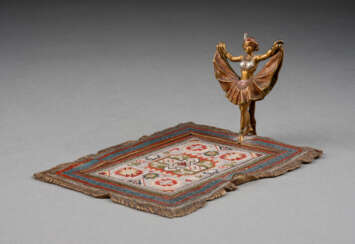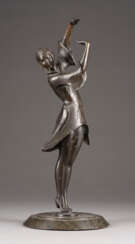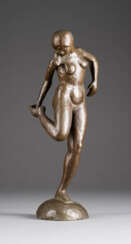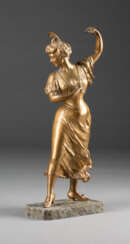bronze tänzerin

Paul Wunderlich was a German painter, sculptor and graphic artist. He designed Surrealist paintings and erotic sculptures. He often created paintings which referred to mythological legends.


Ferdinand Liebermann was a German sculptor.
Liebermann studied sculpture at the School of Arts and Crafts and at the Academy in Munich with Heinrich Wadere. After additional studies in Rome and Paris, he opened his studio in Munich in 1910 and was awarded the Grand Austrian State Medal in gold for a small bronze the same year. In 1926 he became professor of monumental and portrait sculpture in Munich.
Ferdinand Liebermann's works include numerous sculptures of buildings, monuments and fountains, and he was also one of the most important figure designers for the Rosenthal manufactory.


Axel Richter was a German sculptor.
Richter studied sculpture with Reimar von Bonin at the free art school of Münsingen near Freiburg/Breisgau, and worked for 20 years as a chaser at the Elmenhorst foundry, where he also learned the craft of his own bronze foundry.
Since 1993, Axel Richter has participated in numerous solo and group exhibitions. He designed and established the NABU Hamburg Hanseatic Environmental Prize, which has been awarded annually since 1995. Since 2000 he is the initiator and director of the Kunsthaus am Schüberg in Ammersbeck.



Edgar Degas, a French artist, was a master of painting, sculpture, and drawing, celebrated for his profound influence on the Impressionist movement despite his preference for being called a realist. Degas was born into a well-off family in Paris, France, and demonstrated a keen interest in art from an early age, eventually shaping his path to become one of the most sophisticated draftsmen of his time. His rigorous academic training and close study of classical art initially aimed him towards a career in history painting, but Degas soon pivoted towards contemporary subject matter, thus cementing his role as a classical painter of modern life.
Degas is renowned for his dynamic portrayals of movement, particularly in his depictions of dancers, racehorses, and everyday Parisian life. His works are characterized by their psychological depth and the isolation of his figures, showcasing his unique ability to capture the essence of his subjects with both empathy and critical distance. More than half of his oeuvre focuses on dancers, reflecting not only his fascination with the ballet but also his innovative approach to composition and form. This focus on the human figure, explored in various media including oil, pastel, and sculpture, underscores Degas's commitment to studying the nuances of human movement and expression.
Degas's artistic career is marked by his experimentation with various techniques and materials, as seen in his bronze sculptures and pastel nudes. One of his most famous sculptures, the study of the young ballet student Marie van Goethem, showcases his pioneering use of real objects in sculpture, a practice that prefigured later artistic innovations. Despite the controversies that sometimes surrounded his work, particularly in his depictions of the female nude, Degas's legacy as an artist who bridged the gap between traditional academic art and the modern movements of the early 20th century remains undisputed.
For collectors and experts in art and antiques, Degas's work offers a fascinating study in the evolution of modern art, highlighting the artist's deep engagement with the cultural and social dynamics of his time. His pieces, whether in the form of paintings, sculptures, or prints, continue to captivate audiences with their complexity, beauty, and innovative spirit.
If you are keen to stay updated on sales and auction events related to Edgar Degas, signing up for updates is a prudent choice. This subscription service ensures that you remain informed about new opportunities to acquire works by this pivotal figure in the art world, without overwhelming you with unnecessary information.




Fritz Heinemann was a German sculptor. Heinemann belonged to those artists who set themselves apart from the prevailing New Baroque of the time by Reinhold Begas and his students with a tectonic formal language in the sense of Adolf von Hildebrand. Some figures are close to the works of Auguste Rodin. His work covers almost the entire sculptural spectrum: monuments, gravestones, genre figures, busts and small bronzes.


Ernst Seger was a German sculptor and medalist, professor.
Seger studied at the Breslau School of Art with Robert Hertel and Christian Behrens, he also studied in Paris, and from the late 1880s he first executed large commissions for public monuments. The sculptor worked in Auguste Rodin's studio in Paris before opening his own studio in Berlin. Ernst Seger became famous primarily for his Art Nouveau female nudes.












































































